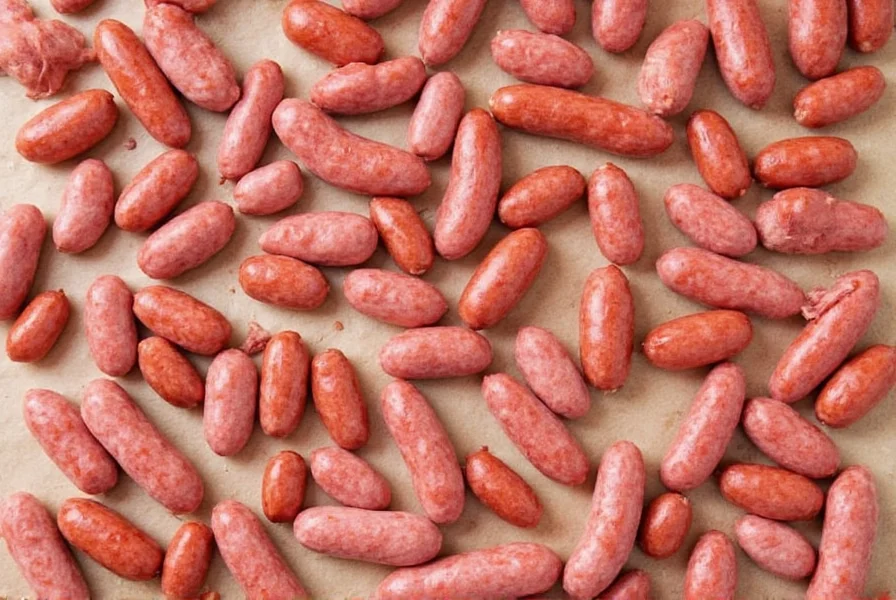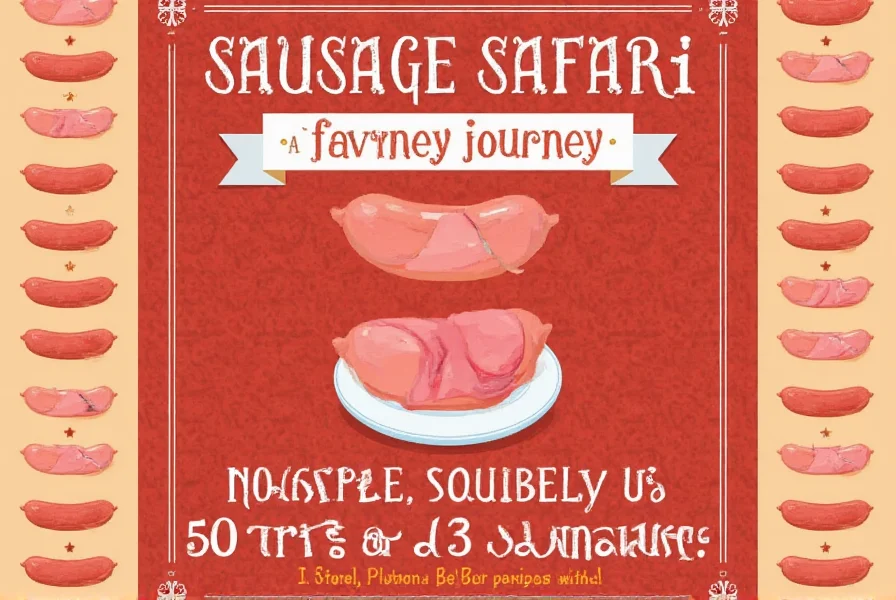Discover 50 Authentic Sausage Varieties from Around the World
Looking for the best sausages to try? This comprehensive guide covers 50 authentic sausage varieties from around the world, with detailed information on flavors, origins, and how to cook them perfectly. Whether you're a home chef or food enthusiast, you'll learn how to select, prepare, and enjoy these global delicacies.
What Is a Sausage? A Cultural and Culinary History
Sausage is more than just ground meat in a casing—it's a global culinary tradition with roots in ancient preservation techniques. Historically developed before refrigeration, sausages allowed communities to use every part of the animal while adding flavor through regional spices. Today, they represent cultural identity, with each region developing unique recipes based on available ingredients and traditions.
Key Components of Authentic Sausage:
- Meat: Pork, beef, chicken, lamb, or game meats (often specified by regional tradition)
- Fat: Essential for moisture and texture (typically 20-30% of total weight)
- Seasonings: Salt, pepper, paprika, garlic, fennel, and regional spices
- Casing: Natural (intestine) for traditional textures or synthetic (collagen/plastic) for consistency
The Evolution of Sausage: A Historical Timeline
Understanding sausage's journey requires examining key milestones verified through archaeological and historical records:
- 8th Century BCE: Earliest physical evidence found in Celtic burial sites (Eberdingen-Hochdorf, Germany), indicating ritual sausage consumption. Source: State Museum of Württemberg
- 1st Century CE: Roman gourmet Apicius documented sausage recipes in "De Re Coquinaria," including minced meat patties with pine nuts. Source: Gutenberg Project
- 1280 CE: Frankfurt am Main officially codified the "frankfurter" sausage, establishing standards that led to its EU Protected Geographical Indication (PGI) status in 1995. Source: EU Geographical Indications Register
- 1992: The EU introduced Protected Geographical Indication (PGI) labels, reviving artisanal traditions for products like Spanish Chorizo and Thuringian Bratwurst. Source: European Commission
Why So Many Sausage Styles? The Role of Geography and Culture
Sausage diversity stems from historical preservation needs, climate conditions, and cultural preferences. Coastal regions developed smoked varieties for longer shelf life, while spice-rich regions like Spain and Mexico created vibrant, paprika-based sausages. Religious dietary laws also shaped sausage development—halal sausages use only beef or lamb, and kosher sausages follow strict Jewish dietary codes.
Regional Sausage Categories Explained:
| Type | Origin | Spice Signature | Traditional Preparation | Cultural Significance |
|---|---|---|---|---|
| Bratwurst | Germany | Marjoram, nutmeg, white pepper | Grilled over beechwood, served with sauerkraut | Symbol of Bavarian culture; often featured at Oktoberfest |
| Chorizo | Spain | Smoked paprika (pimentón), garlic, chili | Cured for 3-6 months, sliced thin for tapas | Integral to Spanish cuisine; regional variations define local identity |
| Kielbasa | Poland | Garlic, marjoram, allspice | Smoked and boiled, served with potatoes and horseradish | Polish national dish; traditionally prepared for holidays |
Top 50 Sausages Worth Trying: Detailed Global Guide
Each sausage has unique characteristics shaped by its origin. Below is a curated selection with in-depth descriptions to help you explore authentic flavors.
Europe
- Andouille (France): A smoked pork sausage originating from Normandy, traditionally made with coarsely ground pork, garlic, and pepper. Smoked over applewood or beechwood for 12-24 hours. Essential for Cajun dishes like gumbo and jambalaya. The French version is milder than its Louisiana counterpart, with a rich, smoky depth perfect for stews.
- Boerewors (South Africa): A spiral-shaped sausage made from beef and lamb, seasoned with coriander, cloves, and nutmeg. Traditionally cooked on a braai (South African barbecue) and served with pap (maize porridge). The name means "farmer's sausage" and reflects its rural origins.
- Boudin Blanc (France): A delicate white sausage made from pork, cream, and herbs like parsley and chives. Unlike blood sausages, it's mild and creamy. Typically poached and served with apples or mustard. A staple in French patisseries and charcuterie boards.
- Frankfurter Würstchen (Germany): The original "hot dog," created in Frankfurt in the 13th century. Made from finely ground pork and beef, seasoned with nutmeg and ginger. Traditionally boiled and served with sauerkraut or mustard. The name "frankfurter" comes from Frankfurt, where it was first produced.
Eastern Europe & Russia
- Gulyashkolbász (Hungary): A paprika-rich sausage named after goulash. Made from beef and pork, with sweet or hot paprika as the dominant flavor. Traditionally smoked and used in Hungarian stews. The name means "goulash sausage" and reflects its role in traditional dishes.
- Kabanosy (Poland): A thin, dried pork sausage that's smoked and air-dried for 2-3 weeks. Known for its intense flavor and chewy texture. Often eaten as a snack with cheese or bread. Originated in Poland but now popular across Europe.
- Kishka (Jewish): A traditional Ashkenazi sausage made from chicken fat, flour, and spices, stuffed into intestines. Often served during holidays like Passover. Modern versions may use vegetarian fillings while maintaining the cultural significance.
Mediterranean & Middle East
- Lukanka (Bulgaria): An air-dried sausage made from pork and beef, seasoned with garlic, black pepper, and paprika. Typically aged for 2-3 months and sliced thin for meze platters. Unique for its cylindrical shape and deep red color from paprika.
- Merguez (North Africa): A spicy lamb sausage flavored with harissa, cumin, and coriander. Originating from Algeria and Tunisia, it's commonly grilled and served with couscous. The name means "red" in Arabic, referring to its vibrant color.
- Tulum (Turkey): A unique sausage aged in goat skin, made from sheep's milk cheese and lamb. The skin acts as a natural casing, imparting a distinct earthy flavor. Traditionally hung in cool caves for aging. A specialty of the Aegean region.
Asia
- Yunnan La Gan Chang (China): A dried sausage from Yunnan province, made with pork, rice wine, and Sichuan pepper. Air-dried for 2-3 weeks, resulting in a salty-sweet flavor. Often steamed and served with rice. Represents Yunnan's ethnic minority culinary traditions.
- Korean Sundae (South Korea): A blood sausage made with pork blood, glass noodles, and barley. Stuffed into intestines and steamed or boiled. Typically served with salt and pepper for dipping. A popular street food with regional variations across Korea.
The Americas
- Chorizo Verde (Mexico): A green sausage made with tomatillos, cilantro, and jalapeños instead of paprika. Unlike Spanish chorizo, it's fresh and requires cooking. Commonly used in tacos or scrambled with eggs. The name means "green chorizo" and reflects its vibrant color.
- Longganisa (Philippines): A vinegar-marinated sausage with garlic, sugar, and annatto. Comes in sweet (hamonado) or savory (de recado) varieties. Typically fried and served with garlic rice. A staple in Filipino breakfasts.
Oceania & More
- Smoked Venison Sausage (New Zealand): Made from wild venison, smoked over manuka wood. Lean and gamey with a rich, earthy flavor. Often used in stews or as a gourmet topping for pizza. Represents New Zealand's sustainable hunting traditions.

Spice Basics for Sausage Lovers: Understanding Flavor Profiles
Sausage flavors are defined by regional spice combinations. Here's how key spices contribute to authentic profiles:
- Fennel Seed: Essential for Italian sausage, providing sweet anise notes. When toasted, it releases oils that balance fatty meats. Used in 80% of European sausages for its digestive properties.
- Paprika: The defining spice for Spanish chorizo. Smoked paprika (pimentón) adds depth, while sweet paprika creates milder flavors. The color intensity varies by region—Spanish paprika ranges from deep red to orange.
- Garlic: A universal base spice, but preparation matters. Fresh garlic adds brightness, while roasted garlic creates mellow sweetness. In Polish kielbasa, garlic is used in higher quantities than in German bratwurst.
- Nutmeg & Marjoram: German classics for bratwurst. Nutmeg adds warmth, while marjoram provides floral notes. These spices are used in precise ratios to avoid overpowering the meat.
- Harissa & Cayenne: For fiery merguez and Mexican chorizo. Harissa (North African chili paste) adds complexity, while cayenne provides direct heat. Proper balance prevents overwhelming the meat's natural flavor.
Professional Tip:
For homemade sausage, always chill meat and spices to 32°F (0°C) before grinding. This prevents fat from melting, ensuring proper emulsification. Use a meat thermometer to maintain safe temperatures during processing—ground meat should never exceed 40°F (4°C) to avoid bacterial growth.

Buying Guide: How to Choose the Right Sausage
Selecting sausages requires understanding their type, storage needs, and intended use. Here's how to make informed choices:
| Sausage Type | Flavor Profile | Best For | Occasion | Storage Requirements |
|---|---|---|---|---|
| Chorizo | Smoky, spicy, rich (Spanish); fresh, herby (Mexican) | Paella, tapas, tacos | Cocktail hour, Spanish night | Spanish: cured, room temperature for 2 weeks; Mexican: fresh, refrigerated 3-5 days |
| Bratwurst | Herby, juicy, mild | BBQ, beer pairing | Tailgating, backyard cookout | Refrigerated 3-5 days; freeze for up to 2 months |
| Italian Sausage | Garlicky, fennel-forward (sweet); spicy with red pepper flakes | Pasta, subs, pizza topping | Weeknight dinners, Italian feast | Refrigerated 3-5 days; freeze for up to 2 months |
| Merguez | Spicy, lamb-y, with harissa depth | Grilling, couscous bowls | Mediterranean night, fusion cooking | Refrigerated 2-3 days; freeze for up to 1 month |
| Kielbasa | Smoky, garlicky, firm texture | Stews, cabbage dishes | Comfort meals, Polish night | Refrigerated 7-10 days; freeze for up to 3 months |
Authenticity Verification: Context Boundaries for Key Varieties
Not all regionally named sausages meet traditional standards. Verified context boundaries ensure authenticity:
- Spanish Chorizo: Must contain Pimentón de la Vera (smoked paprika from specific Spanish regions) to be authentic. The EU PGI certification requires production within designated areas using traditional methods. Sausages without this certification may use generic paprika. Source: EU GI Register for Chorizo de Cantimpalos
- Thuringian Bratwurst: Protected by EU PGI since 2004, it must be made in Thuringia, Germany, with specific meat ratios (min. 51% pork) and seasoned only with salt, pepper, and marjoram. Bratwurst made elsewhere cannot use the name. Source: EU GI Register for Thuringian Bratwurst
- Italian Sausage: No EU protection, but regional varieties like "Salsiccia Romana" have traditional spice profiles. Be wary of "Italian" sausages outside Italy that lack fennel seed (the defining ingredient). Authentic versions use 1-2% fennel by weight.
Key Buying Considerations:
- Freshness: Look for firm texture with no sliminess. Natural casings should be intact and slightly shiny.
- Color: Should match the meat type—pork sausages are pinkish, beef sausages redder, and cured sausages deeper red/brown.
- Spice Level: Check labels for "mild," "hot," or "extra-spicy." For authentic regional sausages, look for specific spice mentions like "pimentón" or "harissa."
- Storage: Fresh sausages require refrigeration; cured sausages can be stored at room temperature for weeks. Always check "use by" dates.
Cooking Tips and Tricks: Mastering Sausage Preparation
Proper cooking techniques preserve flavor and texture. Here's how to handle different sausage types:
- Grilling: Preheat grill to medium heat (350°F/175°C). Rotate sausages every 2-3 minutes to avoid splitting. For fresh sausages, poach first in beer or broth for 8-10 minutes to ensure even cooking.
- Poaching: Simmer in liquid (water, beer, or broth) at 160°F (71°C) for 10-15 minutes. This prevents casing from bursting and ensures thorough cooking before finishing on the grill.
- Skillet Sear: Cook over medium-low heat for 12-15 minutes, turning occasionally. Render fat slowly to crisp the casing without burning. For cured sausages like chorizo, cook until fat renders and edges brown.
- Slow Cooking: Ideal for stews and casseroles. Add sausages during the last hour of cooking to prevent overcooking. Whole sausages hold up better than sliced in slow-cooker recipes.
- Charcuterie Board: Pair dry-cured sausages like salami or kabanosy with complementary items: olives, cheeses, crusty bread, and fruit preserves. Slice thinly for optimal texture.

Frequently Asked Questions About Sausages
What is the difference between fresh and cured sausages?
Fresh sausages (like bratwurst or Italian sausage) must be cooked before eating and are typically consumed within 3-5 days. They contain no preservatives and rely on refrigeration. Cured sausages (like chorizo or salami) undergo smoking, drying, or fermentation to preserve them. They can be eaten without cooking and have longer shelf lives—Spanish chorizo lasts months unrefrigerated, while dry-cured sausages like salami can be stored for weeks. Always check labels for preparation instructions.
How long do sausages last in the refrigerator?
Fresh sausages: 1-2 days for unopened packages, 3-4 days if vacuum-sealed. Cooked sausages: 3-4 days. Cured sausages: 2-3 weeks for unopened packages; once opened, consume within 1 week. Dry-cured sausages like salami can last 2-3 months refrigerated. Always check for signs of spoilage: slimy texture, off odors, or discoloration. When in doubt, discard.
What's the best way to cook sausages without splitting them?
To prevent splitting, cook sausages slowly over medium-low heat. Avoid pricking them with a fork, as this releases juices. Instead, poach first in simmering water or beer for 8-10 minutes until cooked through, then finish on the grill or in a pan for a crispy exterior. For cured sausages, slice thinly and cook gently to avoid drying out. Always let sausages rest for 2-3 minutes after cooking to redistribute juices.
Are all sausages made with pork?
No, sausages use diverse meats based on cultural and religious traditions. Pork is traditional for many European sausages, but beef dominates in Polish kielbasa and Hungarian gulyashkolbász. Lamb is common in North African merguez and Turkish sucuk. Chicken and turkey sausages are popular for leaner options. Religious dietary laws shape many varieties: halal sausages use only beef or lamb, kosher sausages follow strict Jewish guidelines, and vegetarian options use plant-based proteins. Always check ingredient lists for meat sources.
What gives chorizo its distinctive red color?
Spanish chorizo gets its vibrant red color from smoked paprika (pimentón), which varies in intensity based on the type used. Sweet paprika (dulce) creates a mild orange-red hue, while hot paprika (picante) produces a deeper red. Mexican chorizo uses chili peppers like ancho or guajillo for color and heat. The amount of paprika used typically ranges from 2-5% of total weight, with higher percentages creating more intense color. Authentic Spanish chorizo must contain pimentón to meet EU geographical indication standards.
Can I freeze sausages?
Yes, sausages freeze well for 1-2 months. For best results, freeze uncooked sausages in their original packaging or wrap tightly in plastic wrap and aluminum foil. Pre-cooked sausages should cool completely before freezing. Use freezer-safe containers to prevent freezer burn. When thawing, place in the refrigerator overnight—never at room temperature. For cured sausages like salami, freezing is unnecessary as they have long shelf lives, but if frozen, consume within 1 month for optimal texture.
What's the difference between hot and sweet Italian sausage?
Sweet Italian sausage contains fennel seed (typically 1-2% of total weight) and black pepper, with no added chili peppers. It has a mild, aromatic flavor perfect for pasta sauces and pizza. Hot Italian sausage includes red pepper flakes (0.5-1% of total weight) for noticeable heat while maintaining the signature fennel profile. Both use pork as the primary meat, but the spice blend creates distinct flavor experiences. Always check labels for "sweet" or "hot" designations, as regional variations exist.
How can I tell if a sausage is properly cooked?
The safest method is using a meat thermometer: pork, beef, or lamb sausages must reach 160°F (71°C); poultry sausages require 165°F (74°C). Visually, properly cooked sausages will have firm texture with clear juices (not pink). The casing should be browned and slightly crisp. For cured sausages like salami, they're ready to eat as-is, but grilling enhances flavor. Never rely solely on color—some sausages (like chorizo) remain red even when fully cooked due to paprika.
Final Thoughts on This Tasty Tour
Sausage is more than meat in a tube—it's a story of culture, tradition, and spice mastery. With this guide to 50 authentic sausage varieties, you now have the tools to impress at dinner parties, elevate your home cooking, and explore global flavors without leaving your kitchen. Always prioritize quality ingredients and proper cooking techniques to honor these culinary traditions.
Ready to Grill?
Start with a gourmet selection from your local butcher or explore regional specialties at specialty food stores. For authentic experiences, seek out sausages with geographical indication labels (like Spanish chorizo with "Pimentón de la Vera" certification).










 浙公网安备
33010002000092号
浙公网安备
33010002000092号 浙B2-20120091-4
浙B2-20120091-4